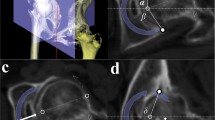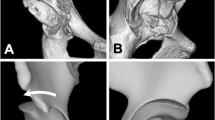Abstract
Background
There is limited understanding of anterior acetabular component overhang, which induces groin pain, in post-periacetabular osteotomy (PAO) hips during conversion to total hip arthroplasty (THA). The aim of the study were to determine the following: (1) the differences in the amount of acetabular component overhang among pre-PAO hips and post-PAO hips in simulating THA; (2) the factors associated with the amount of component overhang in THA following PAO; (3) whether high component placement with elevation of the hip center by 10 mm reduces the amount of component overhang compared to the anatomical component position in THA following PAO.
Methods
Computer-based simulations of acetabular component implantation were performed using preoperative and postoperative CT data from 30 patients undergoing PAO. Implantation was performed thrice in each patient: in pre-PAO hips (anatomical component position) and post-PAO hips (anatomical and high component position). Component overhang was measured on the axial plane, which passes through the component center.
Results
Overhang was greater in post-PAO hips [mean (SD) overhang: 5.2 (2.9) mm, pre-PAO hips: 10.2 (4.6) mm, post-PAO hips-mean difference, 5.0 mm; p < 0.001]. A smaller distance between the pubic osteotomy and the acetabulum, and greater overhang in pre-PAO hips was independent factors associated with increased overhang in post-PAO hips. Overhang was smaller with the high component position than with the anatomical component position in post-PAO hips [mean (SD) overhang-3.5 mm (2.9) with high component position among post-PAO hips; mean difference, 6.6 mm; p < 0.001). Ten post-PAO hips with the anatomical component position had overhang of at least 12 mm (the likely threshold for groin pain). Of these, 9 hips had reduced overhang (< 12 mm) with the high component position.
Conclusions
Acetabular component overhang was more severe in THA following PAO than in THA without prior PAO. Pubic osteotomy should be performed closer to the acetabular rim to prevent severe overhang in potential THA conversion cases. A high component position decreased the risk of severe overhang.





Similar content being viewed by others

References
Ganz R, Klaue K, Vinh TS, Mast JW (1988) A new periacetabular osteotomy for the treatment of hip dysplasias: technique and preliminary results. Clin Orthop Relat Res 232:26–36
Steppacher SD, Tannast M, Ganz R, Siebenrock KA (2008) Mean 20-year follow up of Bernese periacetabular osteotomy. Clin Orthop Relat Res 466:1633–1644. https://doi.org/10.1007/s11999-008-0242-3
Kaneuji A, Sugimori T, Ichiseki T, Fukui K, Takahashi E, Matsumoto T (2015) Rotational acetabular osteotomy for osteoarthritis with acetabular dysplasia: conversion rate to total hip arthroplasty within twenty years and osteoarthritis progression after a minimum of twenty years. J Bone Jt Surg Am 97:726–732. https://doi.org/10.2106/JBJS.N.00667
Hasegawa Y, Iwase T, Kitamura S, Yamauchi Ki K, Sakano S, Iwata H (2002) Eccentric rotational acetabular osteotomy for acetabular dysplasia: follow-up of one hundred and thirty-two hips for five to ten years. J Bone Jt Surg Am 84:404–410
Osawa Y, Hasegawa Y, Seki T (2020) Long-term outcomes of eccentric rotational acetabular osteotomy combined with femoral osteotomy for hip dysplasia. J Arthroplasty 35:17–22. https://doi.org/10.1016/j.arth.2019.07.041
Peters CL, Beck M, Dunn HK (2001) Total hip arthroplasty in young adults after failed triple innominate osteotomy. J Arthroplasty 16:188–195. https://doi.org/10.1054/arth.2001.20903
Parvizi J, Burmeister H, Ganz R (2004) Previous Bernese periacetabular osteotomy does not compromise the results of total hip arthroplasty. Clin Orthop Relat Res 423:118–122. https://doi.org/10.1097/01.blo.0000128287.98083.63
Hartig-Andreasen C, Stilling M, Søballe K, Thilleman TK, Troelsen A (2014) Is cup positioning challenged in hips previously treated with periacetabular osteotomy? J Arthroplasty 29:763–768. https://doi.org/10.1016/j.arth.2013.08.006
Ito H, Takatori Y, Moro T, Oshima H, Oka H, Tanaka S (2015) Total hip arthroplasty after rotational acetabular osteotomy. J Arthroplasty 30:403–406. https://doi.org/10.1016/j.arth.2014.10.002
Fukui K, Kaneuji A, Sugimori T, Ichiseki T, Matsumoto T (2015) Does rotational acetabular osteotomy affect subsequent total hip arthroplasty? Arch Orthop Trauma Surg 135:407–415. https://doi.org/10.1007/s00402-015-2154-5
Osawa Y, Hasegawa Y, Seki T, Amano T, Higuchi Y, Ishiguro N (2016) Significantly poor outcomes of total hip arthroplasty after failed periacetabular osteotomy. J Arthroplasty 31:1904–1909. https://doi.org/10.1016/j.arth.2016.02.056
Tamaki T, Oinuma K, Miura Y, Shiratsuchi H (2016) Total hip arthroplasty after previous acetabular osteotomy: comparison of three types of acetabular osteotomy. J Arthroplasty 31:172–175. https://doi.org/10.1016/j.arth.2015.07.018
Trousdale RT, Cabanela ME, Berry DJ (1995) Anterior iliopsoas impingement after total hip arthroplasty. J Arthroplasty 10:546–549. https://doi.org/10.1016/s0883-5403(05)80160-3
Chalmers BP, Sculco PK, Sierra RJ, Trousdale RT, Berry DJ (2017) Iliopsoas impingement after primary total hip arthroplasty: operative and nonoperative treatment outcomes. J Bone Jt Surg Am 99:557–564. https://doi.org/10.2106/JBJS.16.00244
Cyteval C, Sarrabére MP, Cottin A, Assi C, Morcos L, Maury P et al (2003) Iliopsoas impingement on the acetabular component: radiologic and computed tomography findings of a rare hip prosthesis complication in eight cases. J Comput Assist Tomogr 27:183–188. https://doi.org/10.1097/00004728-200303000-00014
Dora C, Houweling M, Koch P, Sierra RJ (2007) Iliopsoas impingement after total hip replacement: the results of non-operative management, tenotomy or acetabular revision. J Bone Jt Surg Br 89:1031–1035. https://doi.org/10.1302/0301-620X.89B8.19208
Ueno T, Kabata T, Kajino Y, Inoue D, Ohmori T, Tsuchiya H (2018) Risk factors and cup protrusion thresholds for symptomatic iliopsoas impingement after total hip arthroplasty: a retrospective case-control study. J Arthroplasty 33:3288–3296. https://doi.org/10.1016/j.arth.2018.05.017
Osawa Y, Seki T, Takegami Y, Kusano T, Ishiguro N, Hasegawa Y (2019) Failed periacetabular osteotomy leads to acetabular defects during subsequent total hip arthroplasty. Arch Orthop Trauma Surg 139:729–734. https://doi.org/10.1007/s00402-019-03174-y
Wiberg G, Frey H (1940) Studies on dysplastic acetabula and congenital subluxation of the hip joint: with special reference to the complication of osteo-arthritis. JAMA 115:81. https://doi.org/10.1001/jama.1940.02810270083038
Tönnis D, Heinecke A (1999) Acetabular and femoral anteversion: relationship with osteoarthritis of the hip. J Bone Jt Surg Am 81:1747–1770. https://doi.org/10.2106/00004623-199912000-00014
Lewinnek GE, Lewis JL, Tarr R, Compere CL, Zimmerman JR (1978) Dislocations after total hip-replacement arthroplasties. J Bone Jt Surg Am 60:217–220
Yang Y, Zuo J, Liu T, Xiao J, Liu S, Gao Z (2017) Morphological analysis of true acetabulum in hip dysplasia (Crowe classes I-IV) via 3-D implantation simulation. J Bone Jt Surg Am 99:e92. https://doi.org/10.2106/JBJS.16.00729
Ueno T, Kabata T, Kajino Y, Ohmori T, Yoshitani J, Ueoka K et al (2019) Tilt-adjusted cup anteversion in patients with severe backward pelvic tilt is associated with the risk of iliopsoas impingement: a three-dimensional implantation simulation. Clin Orthop Relat Res. https://doi.org/10.1097/CORR.0000000000000830
Takao M, Nakamura N, Ohzono K, Sakai T, Nishii T, Sugano N (2011) The results of a press-fit-only technique for acetabular fixation in hip dysplasia. J Arthroplasty 26:562–568. https://doi.org/10.1016/j.arth.2010.05.025
Murray DW (1993) The definition and measurement of acetabular orientation. J Bone Jt Surg Br 75:228–232
Wells J, Millis M, Kim YJ, Bulat E, Miller P, Matheney T (2017) Survivorship of the Bernese periacetabular osteotomy: what factors are associated with long-term failure? Clin Orthop Relat Res 475:396–405. https://doi.org/10.1007/s11999-016-4887-z
Pagnano W, Hanssen AD, Lewallen DG, Shaughnessy WJ (1996) The effect of superior placement of the acetabular component on the rate of loosening after total hip arthroplasty. J Bone Jt Surg Am 78:1004–1014. https://doi.org/10.2106/00004623-199607000-00004
Kaneuji A, Sugimori T, Ichiseki T, Yamada K, Fukui K, Matsumoto T (2009) Minimum ten-year results of a porous acetabular component for Crowe I to III hip dysplasia using an elevated hip center. J Arthroplasty 24:187–194. https://doi.org/10.1016/j.arth.2007.08.004
Funding
This research did not receive any specific grant from funding agencies in the public, commercial, or not-for-profit sectors.
Author information
Authors and Affiliations
Corresponding author
Ethics declarations
Conflict of interest
Takuro Ueno, Tamon Kabata, Yoshitomo Kajino, Daisuke Inoue, Takaaki Ohmori, Junya Yoshitani, Ken Ueoka, Yuki Yamamuro, and Hiroyuki Tsuchiya declare that they have no conflicts of interest.
Field of research
Bone/Joint.
Additional information
Publisher's Note
Springer Nature remains neutral with regard to jurisdictional claims in published maps and institutional affiliations.
Rights and permissions
About this article
Cite this article
Ueno, T., Kabata, T., Kajino, Y. et al. Association between total hip arthroplasty following periacetabular osteotomy and acetabular component overhang. Eur J Orthop Surg Traumatol 30, 1431–1439 (2020). https://doi.org/10.1007/s00590-020-02714-2
Received:
Accepted:
Published:
Issue Date:
DOI: https://doi.org/10.1007/s00590-020-02714-2



